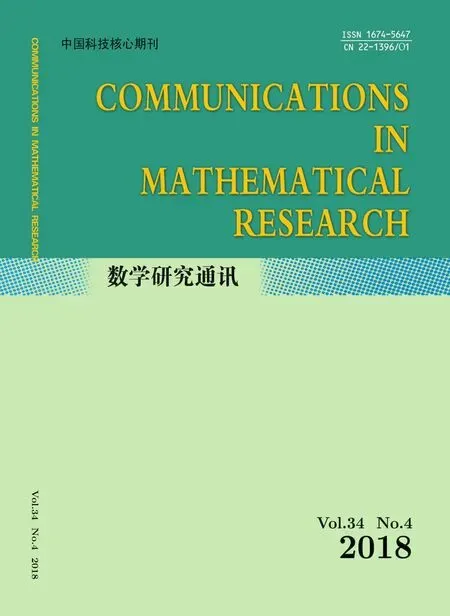Pullback Attractor of a Non-autonomous Model for Epitaxial Growth
Duan Ningand Zhao Xiao-peng,2,*
(1.School of Science,Jiangnan University,Wuxi,Jiangsu,214122)
(2.Department of Mathematics,Southeast University,Nanjing,210096)
Communicated by Gao Wen-jie
Abstract:In this paper,we consider a non-autonomous model for epitaxial growth.It is shown that a pullback attractor of the model exists when the external force has exponential growth.
Key words:pullback attractor,non-autonomous model,asymptotic compactness
1 Introduction
Suppose that ? is an open connected bounded domain in R2with a smooth boundary ??,g is an external forcing term with g∈(R,L2(?)).We are concerned with the following non-autonomous equation:

with the boundary value condition

and the initial condition

Equation(1.1)describes the process growing of a crystal surface.Here,u(x,t)denotes a displacement of height of surface from the standard level u=0 at a position x∈?.The term??2u in(1.1)denotes a surface diffusion of adatoms which is caused by the difference of the chemical potential.In the meantime,denotes the effect of surface roughening.Johnson et al.[1]presented the equation(1.1)for describing the process of growing of a crystal surface on the basis of the BCF theory.Rost and Krug[2]studied the unstable epitaxy on singular surfaces by using(1.1)with a prescribed slope dependent surface current.The problems of stability and global attractor have been studied in various papers(see,e.g.,[3]–[6]).Moreover,based on finite difference methods, finite element methods,the numerical solutions for(1.1)have been studied in some papers(see[7]and[8]and so on).
The pullback attractor for nonautonomous in finite dimensional dynamical systems is important for the study of PDEs,which has attracted much attention and made fast progress in recent years.Caraballo et al.[9]introduced the notion of the pullback D-attractor for non autonomous dynamical systems and gave a general method to prove the existence of pullback D-attractor.Li and Zhong[10]proposed the concept of norm-to-weak continuous process and proved the existence of pullback attractors for the nonautonomous reaction-diffusion equation.The existence of pullback attractor for a nonautonomous modified Swift-Hohenberg equation when its external force has exponential growth was considered in[11].Latterly,the pullback attractor for a generalized Cahn-Hilliard equation and a fourth-order parabolic equation modeling epitaxial thin film growth had been studied by Duan et.al.[12]–[13].
In this paper,we study the existence of pullback attractor for the problem(1.1)–(1.3)by employing the techniques in[10]and[11].We give some basic results on the pullback attractor for non-autonomous dynamical systems.
Suppose that X is a complete metric space and{U(t,τ)}={U(t,τ):t≥ τ,τ∈ R}is a two-parameter family of mappings acting on X.
Definition 1.1[10]–[11]{U(t, τ)}is said to be a norm-to-weak continuous process on X if
? U(t,τ)=U(t,s)U(s,τ)for all t≥ s≥ τ;
? U(τ,τ)=Id(the identity operator)for all τ∈ R;
? U(t,τ)xn→ U(t,τ)x if xn→ x in X.
Suppose that D is a nonempty class of parameterized sets D={D(t):t∈R}?B(X),where B(X)denotes the set of all bounded subsets of X.
Definition 1.2[10]–[11]B=[B(t):t ∈ R} ? D is a family of D-absorbing set for the process{U(t,τ)}if for any t ∈ R and D ? D,there exists a τ0(t,D) ≤ t such that{U(t,τ)}D(τ)? B(t)for all τ≤ τ0(t,D).
Definition 1.3[10]–[11]A process{U(t,τ)}is said to be a satisfying condition(PDC)if for any fixed t∈ R,D ∈ D and any ε>0,there exists a τ0(t,D)≤ t and a finite dimensional subspace X1of X such thatis bounded,and

where P:X→X1is a bounded projector.
Lemma 1.1[10]–[11]Suppose that{U(t,τ)}is a norm-to-weak continuous process on X and
? {U(t,τ)}has a family of D-absorbing set B={B(t):t∈ R}∈ D;
? {U(t,τ)}satisfies the condition(PDC).
Then,{U(t,τ)}has a pullback D-attractor in X.
Throughout this paper,we denote(·,·)as the inner product of L2(?)and ∥ ·∥ as the induced norm. ∥·∥Xdenotes the norm of a Banach space X.For simplicity,we denote∥·∥Lp(?)by ∥·∥p.Set A= ?2and λ be the first eigenvalue of A.For the external force g,we assume that there is a non-negative constant β such that

where 0≤α<λ.Then,simple calculation shows that

By a standard method,we can prove that for every τ∈ R and uτ∈ H20(?),there exists a unique solution u(x,t) ∈ C([τ,∞),H20(?))(see[4]).Moreover,the solution u(x,t)is continuous with respect to the initial value condition uτin the space H20(?).In order to construct a process{U(t,τ)}for problem(1.1)–(1.3),we de fi ne U(t,τ):H20(?)→ H20(?)by U(t,τ)uτ.Thus,the process{U(t,τ)}is a norm-to-weak continuous process in the space H20(?).
Now,we give the main result of this paper,which will be proved in the next section.
Theorem 1.1The process corresponding to problem(1.1)–(1.3)possesses a unique pullback D-attractor in the space H20(?).
2 Proof of Theorem 1.1
In this section,we study the existence of pullback attractors for non-autonomous problem(1.1)–(1.3).
First of all,we derive uniform estimates of solutions for problem(1.1)–(1.3),which are necessary for proving the existence of absorbing set of{u(t,τ)}associated with the problem.
Lemma 2.1Considering the problem(1.1)–(1.3),for all t≥ τ,we have

Proof. Note that

Multiplying(1.1)by u and integrating it over ?,we obtain

Multiplying(2.2)by eλ(t?τ)and integrating it over(τ,t),we derive that

Multiplying(2.3)by eλtand integrating it over(τ,t),we deduce that

Similarly,multiplying(2.1)by eλtand integrating it over(τ,t),we get

Then the proof is completed.
Lemma 2.2Considering the problem(1.1)–(1.3),for all t≥ τ,we have

Proof. Multiplying(1.1)by?2u and integrating it over ?,we derive that


Multiplying this by(t? τ)eλtand integrating it over(τ,t),we obtain

The proof is completed.
Suppose that R is the set of all function r:R→(0,∞)such that

Denote by D the class of all families:={D(t):t∈R}?B((?))such that D(t)?(r(t))for some r(t)∈R,(r(t))denote the closed ball in(?)with radius r(t).Let

Using the continuity of embedding(?),→L2(?),for any?D∈D and t∈R there exists a τ0(?D,t) Furthermore,since 0≤ α<λ,we get(r0(t))∈D.Therefore,(r0(t))is a family of bounded pullback D-absorbing sets in(?). Now,we give the proof of Theorem 1.1. Proof of Theorem 1.1In order to prove the existence of pullback attractor for the problem(1.1)–(1.3),we need only prove that the process{u(t,τ)}is pullback ω ? D-limit compact(PDC).Thanks to A?1is a continuous compact operator in L2(?),there exists a sequencesatisfying Taking the scalar product of(1.1)with ?2u2,using Young’s inequality,we get Multiplying(2.10)by(t? τ)eλntand integrating it over(τ,t),we deduce that It then follows from(2.9)and(2.11)that On the other hand,simple calculations show that Adding(2.12),(2.13)and(2.14)together,we can obtain for any ε>0,there exists a τ0 This infer that the process{U(t,τ)}is pullback ω-D-limit compact.Then,by Theorem 3.5 in[10],the process corresponding to the problem(1.1)–(1.3)possesses a unique pullback D-attractor in H20(?).







 Communications in Mathematical Research2018年4期
Communications in Mathematical Research2018年4期
